The legendary T-34
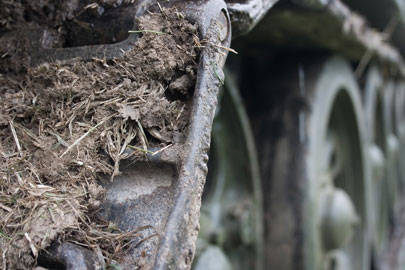
What kind of people were fighting the thirty-three? How and where were they trained? What did the battle look like “from the inside” and what were the front days of the Soviet tankers like?
Training tankers to ...
Before the war, the personnel commander tanker trained for two years. He studied all types of tanks that were in the Red Army. He was taught to drive a tank, shoot from his cannon and machine guns, gave knowledge of the tactics of tank combat. A general specialist was leaving the school. He was not only the commander of a combat vehicle, but also knew how to perform the duties of any crew member.
In the thirties, the military enjoyed great popularity in the USSR. First, the Red Army, its soldiers and officers, symbolized the power of the relatively young Soviet state, which in just a few years had turned from a war-torn, impoverished, agrarian country into an industrial power capable of standing up for itself. Secondly, the officers were one of the most well-to-do.
For example, the instructor of the aviation school, in addition to the full content (uniforms, meals in the canteen, transport, dormitory, or rent money) received a very high salary — about 700 rubles (a bottle of vodka cost around two rubles). In addition, to those who came from the peasant environment, service in the army gave a chance to improve education, to master a new, prestigious specialty.
Alexander Burtsev, tank commander: “I remember that after three years of service, they returned from the army by other people. The village burdock was leaving, and a competent, cultured man, well-dressed, in a tunic, pants, boots, physically fit, was returning. He could work with technology, manage. When a serviceman came from the army, they were called that, the whole village was going to. The family was proud that he served in the army, that he became such a man. ”
The coming new war — the war of engines — also created new propaganda images. If in the twenties back every boy dreamed of drafts and cavalry attacks, by the end of the thirties this romantic image was forever supplanted by fighter pilots and tank crews. To pilot a fighter or shoot an enemy from a tank gun was what thousands of Soviet guys were dreaming about now. “Guys, let's go to tankmen! Honorable! You go, the whole country is under you! And you are riding an iron horse! ”- phrases describing the mood of those years, recalls the platoon commander, Lieutenant Nikolai Yakovlevich Zheleznov.
... and during the war
However, during the heavy defeats of 1941, the Red Army lost almost all the tanks that it had in the western districts. Killed and most personnel tank crews. The shortage of sharp tank crews became apparent already in the summer of 1942, when the industry evacuated to the Urals began producing tanks in the previous volumes.
Realizing that tankmen would play a decisive role in the 1943 campaign of the year, the leadership ordered the fronts to send at least 5000 best privates and sergeants to at least seven classes to tank schools every month. In the tank training regiments, where the rank and file were trained - gunners-radio operators, driver mechanics and loaders, 8000 of the best soldiers with education no less than three classes responded monthly from the front. In addition to the front-line soldiers, yesterday's secondary school graduates, tractor drivers and combine operators sat on the school bench.
The course of study was reduced to six months, and the program was shortened to a minimum. But I still had to do 12 hours a day. Basically, they studied the material part of the T-34 tank - undercarriage, transmission, cannon and machine guns, a radio station.
All this, as well as the ability to repair the tank, was learned both in classrooms and in practical classes. But time was sorely lacking. The platoon commander Vasily Bryukhov recalls: “After graduating from college, I fired three projectiles and a machine-gun disk. Is this training? We were taught a little driving on the BT-5. Gave the basics - to get under way, drive in a straight line. There were classes in tactics, but mostly “tank-wise”. And only at the end there was an ostentatious occupation "tank platoon in the offensive." Everything! Our training was very weak. When we were let out, the head of the school said: “Well, well, sons, we understand that you quickly skipped the program. You have no solid knowledge, but in battle you will complete the education. ”
From school - to the front
Freshly baked lieutenants were sent to tank factories in Gorky, Nizhny Tagil, Chelyabinsk and Omsk. The battalion of T-34 tanks descended daily from the conveyors of each of these plants. The young commander filled out the form of admission tank. After that, he received a penknife, a silk scarf for filtering fuel, a revolver, and a fist-sized tank watch, which were mounted on an instrument panel. However, tankers often carried them with them. Wrist or pocket watches at that time were not for everyone.
Ordinary crew members were trained on three-month courses in spare tank regiments, located at the factories. The commander quickly got acquainted with the crew and made a fifty-kilometer march, which ended with combat shooting.
After that, the tanks were loaded onto platforms, and the train was rushing them to the west - towards fate.
Inside the T-34
The legendary medium tank, adopted by the 1940 year, was in many ways a revolutionary design. But, like any transitional model, he combined novelties and forced solutions. On the first tanks there was an outdated gearbox. The roar in the tank was incredible, and the tank intercom worked disgustingly. Therefore, the tank commander simply put the driver's legs on his shoulders and drove them with predetermined signals.
The T-34 tower was only for two. Therefore, the tank commander served as commander and gunner. By the way, the commander and loader somehow, but could talk, but most often their communication also took place with gestures. The commander shoved his fist under his nose, and he already knows that it is necessary to charge the armor-piercing, and the outstretched palm - shrapnel.
Radio-gunner Pyotr Kirichenko recalls: “Shifting gear required tremendous effort. The driver will lift the lever to the desired position and begin to pull it, and I grab it and pull it with it. The transmission waits for a while and only then turns on. Tank march all consisted of such exercises. During the long march, the driver lost about two or three kilograms in weight: he was all exhausted. In addition, since his hands are busy, I took the paper, poured in a samosad or a shag, stuck it, lit it, and inserted it into his mouth. It was also my duty. ”
Fight on T-34 (reconstruction)
Before the start of the attack remains a few minutes. The commander begins to walk hands shaking, teeth chatter: "How will the battle? What is there behind the knoll? What are the Germans strength? Will I live to see the evening? ”The radio-gunner nervously gnaws a lump of sugar - always pulling him before the attack on food. Charger smokes, deep in smoke. The cigarette in his hand trembles. But in the commander’s tank’s headphones, the signal for an attack sounds. The commander switches to internal communication, but the crackling sound is such that nothing is heard. Therefore, he just lightly hits the driver’s head with the boot, who sits right below him - this is a conditional “Forward!” Signal. The car, roaring by the engine, clanging the tracks, starts to move. The commander looks through the periscope - the entire battalion moved to the attack.
Fear is gone. There is only a cold calculation.
A mechanic drives a car at a speed of 25-30 kilometers - zigzagging, changing direction every 50 meters. From his experience depends on the life of the crew. It is the mechanic who must correctly assess the terrain, find shelter, and not substitute the board under the enemy's weapons. The radio operator set up the radio for reception. He has a machine gun, but he can only take aim through a hole with a diameter of his index finger, in which the sky and the earth alternately flash — you can only frighten Fritz with this kind of shooting, there’s not much real sense from it. Charging in panorama monitors the right sector. His task is not only to throw shells into the breech, but also to indicate the target commander to the right along the course of the tank.
The commander looks ahead and to the left, looking for targets. The right shoulder rested against the breech of the cannon, the left shoulder — against the armor of the turret. Closely. The hands are folded crosswise: the left is on the mechanism for lifting the gun, the right is on the handle of the turn of the tower. Here he caught the enemy tank in the panorama. He pushed his foot into the back of the driver - “Stop!” And just in case shouted at the intercom: “Short!”. Charging: "Armor-piercing!"
The mechanic driver chooses a flat stretch of terrain, stopping the car, shouting: “Track!” Trying to shout down the roar of the engine and the clang of the shutter, reports: “The armor-piercing is ready!”
The tank, abruptly stopping, is still swinging for some time. Now everything depends on the commander, on his skills and simply on luck. A fixed tank is a tasty target for the enemy! From the strain of sweat back. The right hand rotates the rotating mechanism of the tower, combining the aiming mark with a goal in the direction. The left hand turns the mechanism of lifting the gun, combining the brand in range.
“Shot!” Shouts the commander and presses the pedal of the gun's descent. His voice drowns in the roar of the shot and the clang of the shutter. The fighting compartment is filled with powder gases that corrode the eyes. The fan installed in the tower does not have time to blow them out of the tank. The charger grabs a hot steaming sleeve and throws it out through the hatch. Without waiting for the command, the mechanic pulls the car off.
The enemy has time to make a return shot. But the projectile only ricochets, leaving a furrow on the armor, like a hot spoon in oil. From hitting the tank rings in my ears. Dross, flown away from armor, digs into the face, creaks on the teeth. But the battle continues!
T-34 against the "Tigers"
T-34 surpassed all German tanks in all respects. It was a maneuverable and fast medium tank, equipped with a long-barreled 76-mm cannon and a diesel engine. A special subject of tankers pride was the distinctive feature of the "thirty-four" - sloping armor. The effectiveness of oblique armor was confirmed by the practice of fighting. Most of the German anti-tank and tank guns 1941-42 did not penetrate the frontal armor of the T-34 tank. By 1943, the T-34 became the main combat vehicle of the Soviet tank armies, replacing the outdated T-26 and BT.
However, by the 1943 g, the Germans created the old medium tanks T-IV and began to produce the heavy tankers TV Panther and T-VI Tiger. The long-barreled 75 and 88 mm guns on the new machines could hit the T-34 at a distance of 1,5-2 thousands of meters, while the 76 mm gun of our medium tank could hit the Tiger with only 500 meters and the Panther with 800 meters . Using the advantage of T-34 in maneuverability and tactical tricks, our tankers often emerged victorious from fights with a technically superior opponent. But it happened and vice versa ...
If a tank is hit ...
Well, if the shell hit the engine compartment - the tank just gloh and the crew managed to jump out. If the shell pierced the armor of the tower or side of the fighting compartment, then fragments of armor most often wounded someone from the crew. Spread of fuel flared up - and all the hope for the tank crew remained only for themselves, for their reaction, strength, dexterity, because in reserve each had only two or three seconds to escape.
Even worse was that whose tank was just immobilized, but did not burn. Ion Degen, a tanker, said: “In battle, the commander’s order was not required to leave the burning tank, especially the commander could have already been killed. They jumped out of the tank intuitively. But, for example, it was impossible to leave the tank, if you only killed the caterpillar. The crew was obliged to fire from a place until they were beaten. ”
And it happened so that a tanker was not allowed to leave a burning car by any trifle, sometimes even uncomfortable clothing. Tankist Konstantin Shits recalls: “Our commander of one of the companies was Senior Lieutenant Sirik, a prominent man like that. Somehow, rich trophies were captured at the station, and he began to wear a good, long Romanian coat, but when they were hit, the crew managed to jump out, and he hesitated because of this coat and burned down ... "
But when they were lucky, the tankers jumped out of the burning tank, crawled off into the craters and immediately tried to retreat to the rear.
Having survived the battle, "horseless" tankers entered the reserve battalion. But the rest did not work. Repairmen quickly restored not burned tanks. In addition, the plants are constantly replenished parts of the new technology. So literally in two or three days the tanker was included in the new, unfamiliar crew, and in the new tank they again went into battle.
Commanders are always harder
It was even harder for the commanders of companies and battalions. Those fought until the last tank of their compound. This means that the commanders were transferred from one wrecked car to a new one several times during one operation, or even one day.
Tank brigades "grinded to zero" for two or three weeks of offensive battles. After that, they were assigned to re-form. There, tankers first of all put the rest of the equipment in order and only then themselves. The crew, regardless of the ranks, fueled the car with fuel, loaded it with ammunition, cleaned the cannon and calibrated the scope, checked the equipment and mechanisms of the tank.
The charger cleaned the shells from lubrication - washed them in diesel fuel, and then wiped it dry with a cloth. The driver controlled the mechanisms of the tank, poured buckets of fuel, oil and water. The gunner-radio operator and the commander helped them - nobody disdained with dirty work. The fate of the tank depended on the crew, but the life of the crew was also directly related to the state and combat capability of the tank.
Prepared the car for the upcoming battle or march - now you can wash, shave, eat and, most importantly, sleep. After all, the tank was for the crew not only a combat vehicle, but often also a home.
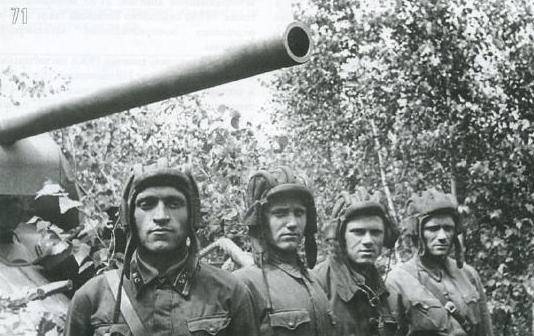
Gen. tank crews
The tank tarpaulin size 10 on 10 meters was attached to the turret of the tank. They crew covered the tank on the way to the front. On it uncomplicated food was laid out. The same tarpaulin served tankers and a roof overhead, when it was not possible to stop for the night in houses.
In winter, the tank froze and became a real "fridge". Then the crew pulled out a trench, drove a tank on top of it. Under the bottom of the tank was hung "tank stove", which was heated with wood. In such a dugout it was not very comfortable, but much warmer than in the tank itself or on the street.
The habitability and comfort of the thirty-fours themselves were at the minimum necessary level. The tankers' seats were made rigid and, unlike the American tanks, they did not have armrests. However, tankers sometimes had to sleep right in the tank - half-sitting. Senior Sergeant Pyotr Kirichenko, gunner-radio operator T-34, recalls:
“Although I was long and thin, I still managed to sleep in my seat. I even liked it: you throw away your back, lower your boots, so that your legs do not freeze over your armor, and you sleep. And after the march to sleep well on a warm transmission, covered with a tarp. "
Spartan tankers lived forcedly. In the offensive they did not even have the opportunity to bathe or change clothes. Tankman Gregory Shishkin says:
“Sometimes you don't wash for a whole month. And sometimes it's fine, once in 10 days you wash yourself. Bath did so. A hut was built in the forest, it was covered with lap trees. On the floor, too, lapnik. There were several crews. One drowns, another chops wood, wears the third water. ”
In the period of intense battles, even tankers often delivered food only at the end of the day — breakfast and lunch and dinner at once. But at the same time tankers supplied dry ration. In addition, the crew never neglected the opportunity to carry a supply of food in a tank. In the offensive, this stock became practically the only source of food, which was replenished with trophies or thanks to the help of the civilian population. “The tankers have always had a good supply. And, of course, food trophies were for us an additional ration ... And the tank NZ was always eaten before the fighting - what if we burned, so why should the good be lost? ”Says tanker Mikhail Shister.
In the evening after the battle it was possible to drink “the People's Commissar hundred grams”. But before the battle a good commander always forbade his crew alcohol. The crew commander Grigory Shishkin about this particular tank crew: “The main thing is that everyone drinks around. The sappers begin: “Hey you, Chernopuz, what don't they give you?” At first, the guys were offended, and then they realized that I was trying for them. After the fight, how much you want to drink, and before the fight in any case! Because the road is every minute, every second. Blundered - dead! ”
Rested, dropped fatigue past battles - and now, the tankers are ready for new battles with the enemy! And how many more of these fights were ahead on the way to Berlin ...
- http://xxl-online.ru"rel =" nofollow ">http://xxl-online.ru
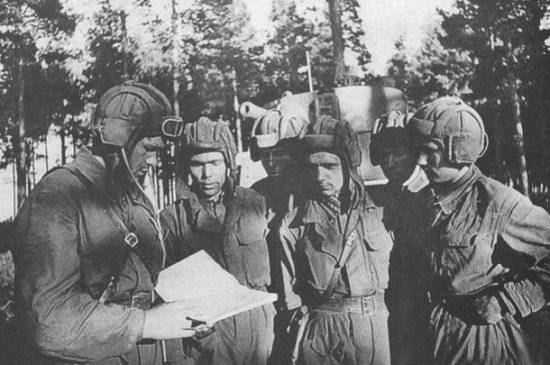
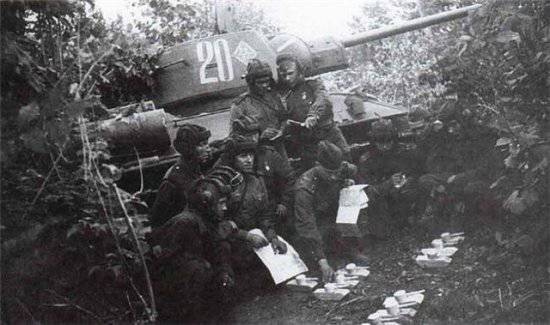
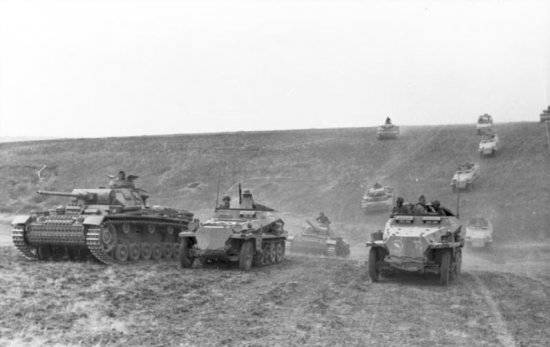
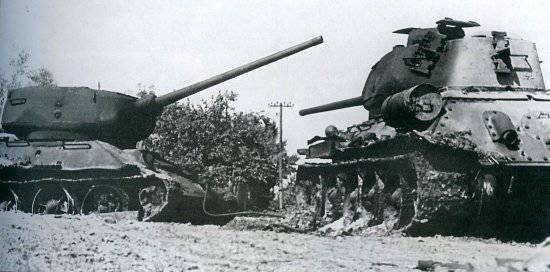
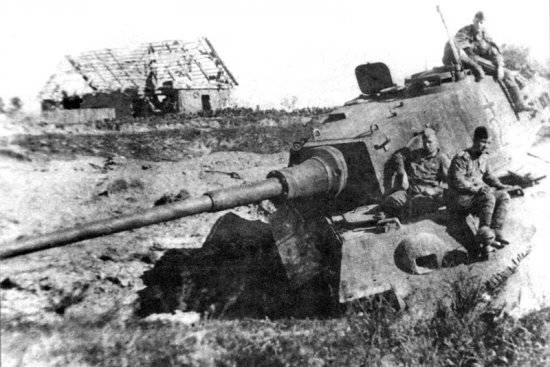
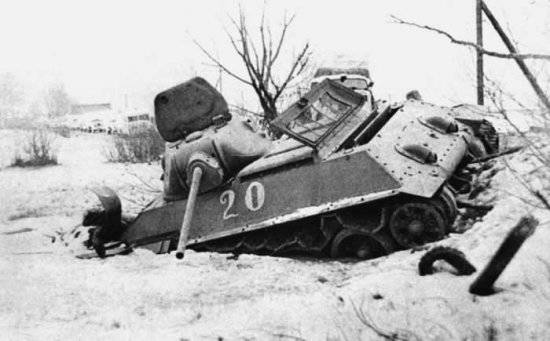
Information